This article was originally published as a feature in Resonate Magazine (the Australian Music Centre) on January 29th, 2015.
In early 2014, I received a Synapse Residency from the Australia Council for the Arts and the Australia Network for Art and Technology (ANAT). Synapse is an initiative that supports collaborations between artists and scientists through an exploratory research process without the expectation to produce a new work.
My proposal was designed as an interdisciplinary collaboration to explore the creative and scientific possibilities of listening to rivers. The core ideas emerged out of a series of my creative projects inspired by rivers over the last ten years. This body of work begins with instrumental compositions, drawing inspiration from rivers, and develops into immersive sound installations and electroacoustic works using field recordings from river systems. During this time, hydrophone (underwater) recordings became integral to my practice. I am always eager to hear beneath the surface of the river – while we might think of rivers as quiet environments, there is often a captivating sound world just beneath the surface.
One of the most critical outcomes of my larger rivers collaborations such as Sound Mirrors (2009-2011) and The DAM(N) Project (2011-2013) was realising the opportunities for hydrophone recordings as a measure for river health. The soundscapes of rivers can expose many qualities, including the active marine life. While I could never predict exactly what the river would sound like when I lowered the hydrophones into the water, the resulting recordings were always extremely revealing. The polluted and stagnant waterways were silent, often with a hum of anthropogenic sound from boats and machinery on the riverbanks. The healthy waterways were filled with sound ranging from dolphins, fish, and turtles to shrimp and insects. I regularly used this material in my compositions and while some sounds were very easy to identify, others were left with question marks.
Considering our current state of environmental crisis and the dramatic need to conserve river systems, one would think aquatic bioacoustics would be a fairly active field. Biodiversity assessment is critical to understanding the rapid ecological changes taking place across the globe. In the last ten years, bioacoustics and acoustic ecology have continued to emerge as extremely valuable fields for non-invasive environmental monitoring involving auditory recordings of the environment. I have been active in this field for a number of years, and while there are countless studies on terrestrial bioacoustics, there are only a handful of studies exploring aquatic bioacoustics in freshwater environments. Often these studies have focused on specific species identification. I soon realised there were many possibilities to explore a holistic approach to river listening from a scientific and creative perspective.
The Synapse Residency was a fantastic opportunity to experiment and develop a truly interdisciplinary foundation while in residence at the Australian Rivers Institute (ARI). ARI is Australia’s largest university aquatic ecosystem research group with globally recognised expertise in river, catchment and coastal ecosystems. While my initial proposal involved several researchers at ARI, the scientific grounding of the River Listening collaboration is led by ARI Senior Research Fellow Dr Simon Linke, one of the world’s leading freshwater conservation scientists, whose pioneering work in biomonitoring and river conservation planning has been used by agencies and NGOs from South East Queensland to the Congo. Simon is also a musician with a strong interest in bioacoustics and was introduced to me by Toby Gifford, a music technologist from the Queensland Conservatorium of Music. Toby had been exploring some concepts in machine listening for aquatic bioacoustics and is a specialist in real-time audio processing. This sparked the beginnings of our collaboration and a year of experimental research and creative development.
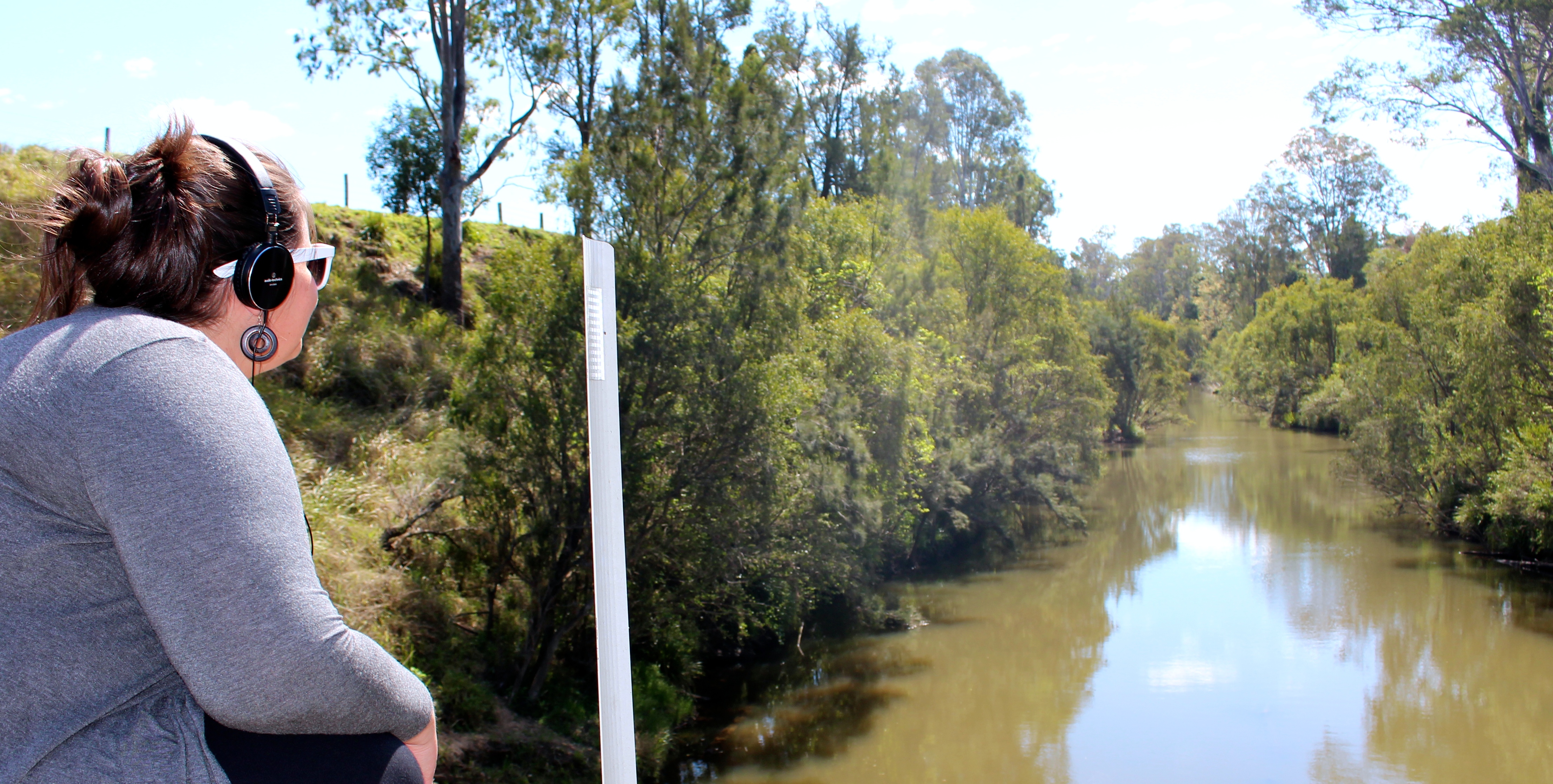
River Listening was designed to extend on the existing creative work I have done in this area and explore new approaches to the conservation of river systems. The process involved not just composing but collaborating with communities, listening to each river, and responding and adapting to other processes that may emerge. Dr Linke believes that classic techniques for measuring aquatic biodiversity are problematic as they potentially injure the study organism (such as electrofishing) and only provide a snapshot at the time of observation rather than a continuous time series.
Despite the rapidly growing interest in emerging auditory fields such as bioacoustics, there are as yet no standardised approaches to field recording and interpreting the data. While scientists have developed advanced software tools for species recognition, there is a growing need to consolidate the available tools and explore the value of listening to the data in new ways. There are also exciting possibilities to make this data available for a wider audience through digital technology and creative collaborations.
River Listening was initially developed across four Queensland river systems: the Brisbane River, the Mary River, the Noosa River and the Logan River. The initial phase of the project involved listening labs, field recording, sound mapping, performances and installations to experiment with hydrophonic recording, virtual technologies and community engagement in understanding river health and aquatic biodiversity. My initial concept involved creating a sound map of each river system from a custom-designed quadraphonic hydrophone rig that would travel the length of each river. While this initially provided some entertaining video footage, a kayak filled with recording equipment splashing around in a river did not exactly attract the local wildlife. Our approach adapted quite quickly and it evolved organically with each community, often through workshops and developing partnerships that allowed us to focus on sounds specific to each river system.
Among these partnerships is Tiaro Landcare, a small not-for-profit organisation based in rural communities along the iconic Mary River. The organisation has been instrumental in the conservation of the endangered Mary River turtle and is comprised of some of the most passionate and committed community volunteers I have encountered. Leading the local research team is Marilyn Connell, a turtle specialist with incredible knowledge about the ecosystem of the Mary River. Marilyn was intrigued by our project and was immediately enthralled by hearing the soundscapes beneath the surface of the Mary River.
This collaboration has continued to develop, and Tiaro Landcare hosted our first River Listeningperformance in late 2014, most likely the only multi-channel electroacoustic music performance on the side of the Bruce Highway in Tiaro. While some of the locals were noticeably confused, others were curious and intrigued and the project has continued to develop into exciting territory. We are very pleased to have just received a grant from the Mohamed bin Zayed Species Conservation Fund to develop a series of community tools and creative projects to monitor the endangered Mary River turtles through sound. The Fund is an international initiative to support innovative research and elevate the importance of species in the broader conservation debate.
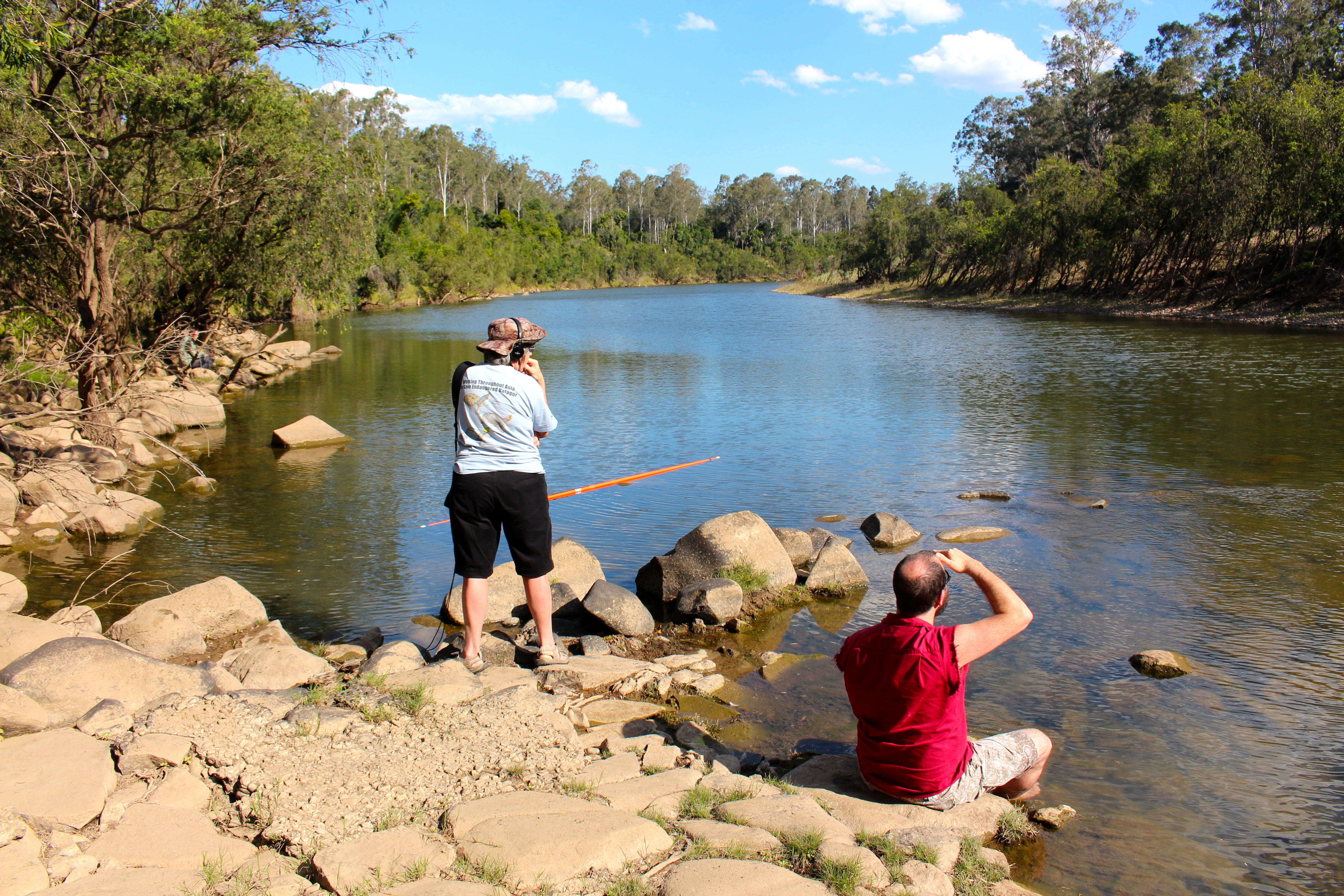
The Queensland river systems share many similarities in terms of climate and biodiversity, and many of the resulting soundscapes certainly share key features. In direct contrast, we launched the pilot for the River Listening sound installation on the Thames in London during the 25th Anniversary of the EVA London Conference in 2014.
Listening to the Thames explored real-time hydrophonics as a means to revealing the hidden world beneath the river surface. The live stream was hosted on PlaceStories, and supported by Feral Arts. While I have used PlaceStories for previous river projects and regularly used the live streaming interface, this was the first time we streamed hydrophones continuously for five days.
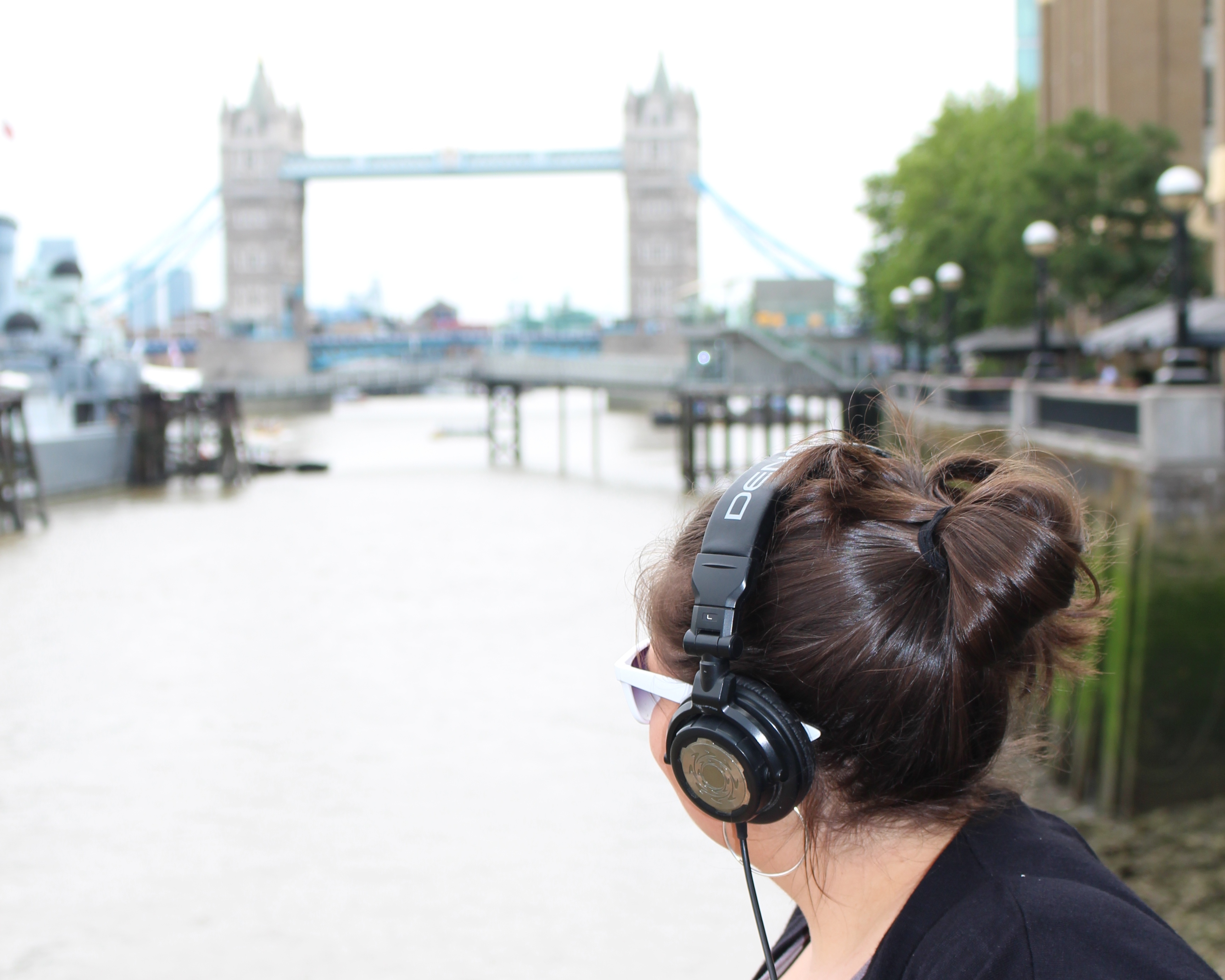
The Thames was incredibly loud, to the point that at times it sounded like a busy highway. Many people in London were surprised by the intensity of the sound, and this provided a great starting point to talk about the value of bioacoustics in understanding river health and the dramatic contrasts of the soundscapes in global river systems that might look similar on the surface. While the focus was on the EVA sound installation, we used the hashtag #RiverListening to encourage people to listen to the live stream and interact online. Listening to the Thames gained the attention of the marketing department at Griffith University who hosted a launch event in London and enabled us to engage with some local organisations including the River Thames Society.
We have had a wide spectrum of creative outcomes in the first six months. Highlights include premiering my immersive River Listening sound installation at the ASU Art Museum in the USA during the Listen(n) Symposium, and launching the first experiment for our interactive sound installation at the Mary River Festival in Queensland. The second installation uses transducers and bone conduction to give audiences the sensation of listening underwater. We have also expanded the project internationally with partnerships formed across the Asia-Pacific and USA, and are continuing to explore new methods of community engagement.
River Listening is currently being featured as a case study in a new masterclass series with UNESCO launching in February 2015 and was also invited to the 2014 IUCN World Parks Congress. In 2015 we hope to launch a customised digital platform and mobile application that will allow communities to record and upload sounds to explore and compare global river health.
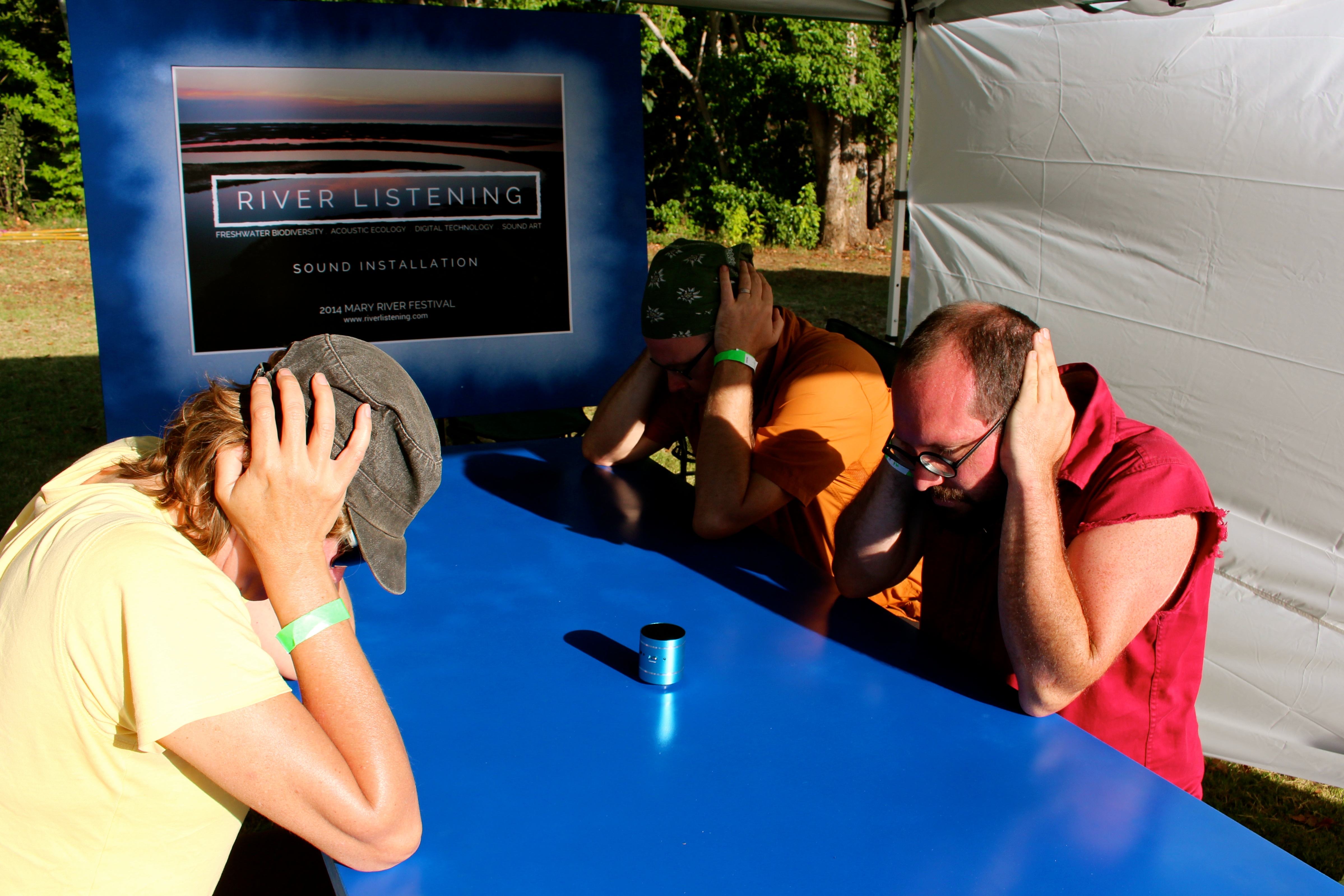
Late last year I found myself presenting this project to UNESCO diplomats in Indonesia. One representative from Pakistan spoke about the current tragedies with the floods in Pakistan and questioned what value is there in listening to a river when thousands of people are losing their lives. While this is clearly extremely challenging to answer it sparked an interesting conversation around the value of culture, technology, sound and music as tools for community empowerment, awareness and global engagement in catastrophic natural disasters. Because communities do not just need to rebuild infrastructure in these situations, they also need to rebuild culture and have access to tools that can give communities a voice in these times of crisis.
While listening to a river does not serve any obvious immediate benefits in these circumstances, it can offer a way to reconnect communities to the environment and act as a platform to collaborate.
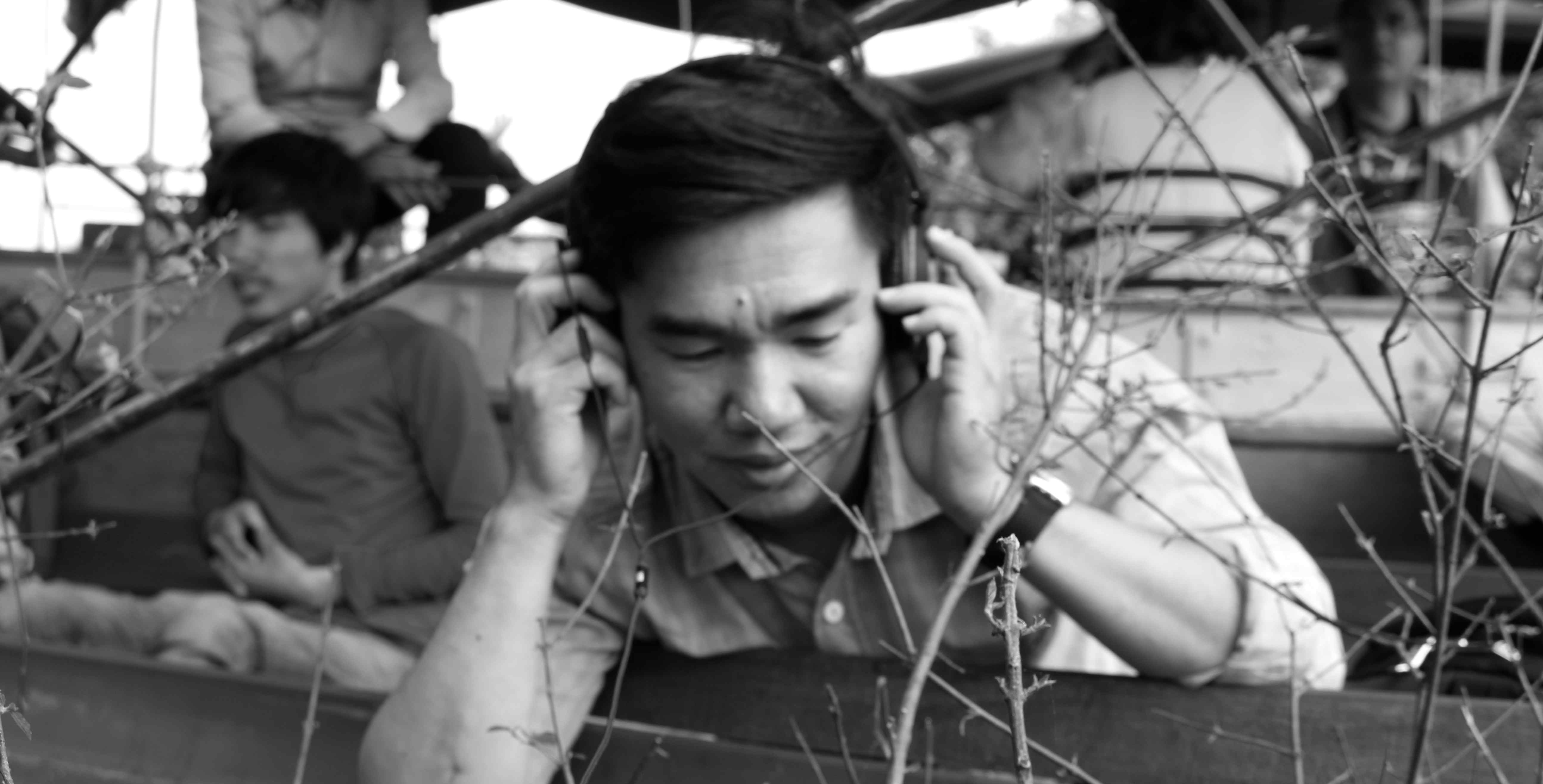
As rivers across the world continue to be impacted by human activity and natural disasters, theRiver Listening project is designed to bring attention to rivers through compositions, sound installations and community engagement while being deeply grounded in the possibilities of hydrophone recording. As the international interest in the emerging auditory fields of bioacoustics and acoustic ecology continues to expand, there are clear opportunities to harness virtual technologies to develop accessible community engagement around the creative and scientific possibilities of listening to the environment. River Listening is a catalyst for interdisciplinary thinking at a time when the management of aquatic ecosystems is a critical priority and we urgently need new ways to engage communities in river conservation.
The Synapse Residency has been an exceptional opportunity to experiment and collaborate without the pressure of a fixed outcome. I have been able to explore interdisciplinary ideas without any restrictions, and this has resulted in a wide spectrum of potential projects spanning from collaborations with local primary school children to international research partnerships with large non-governmental organisations. The opportunity to collaborate with some of Australia’s leading scientists has been instrumental in expanding and challenging my creative ideas and also exposed the true value of interdisciplinary research and the exciting possibilities that are ignited when working in balanced collaborations.
While River Listening might seem far removed from what we traditionally associate with being a composer, it has been a natural process with an identical intention to many of my compositions. What I love most about working on projects such as River Listening is that they expand beyond what I had initially conceived and take on a life of their own in collaboration with communities. I love the inherently interdisciplinary nature of sound, and its ability to create that sense of wonder and curiosity, particularly in young people. It is this generation who will experience the true ramifications of climate change and I feel like it is critical these projects are engaging and relevant to young people.
I am inspired to create projects that are accessible at a micro and macro level, from the UNESCO diplomats in Pakistan, who are challenged with rebuilding culture in displaced communities, to rural land care groups in Queensland who are trying to monitor an endangered turtle, to a six-year-old with a toy motor boat who suddenly realises the sound of his boat could frighten the fish. River Listening is fundamentally designed to explore creative ways that sound, and just the simple process of listening to the environment can inspire how we think and act in these times of ecological uncertainty.
© Australian Music Centre (2015) — Permission must be obtained from the AMC if you wish to reproduce this article either online or in print.
Dr Leah Barclay is an award-winning composer, sound artist and creative producer working at the intersection of art, science and technology. Her work has been commissioned, performed and exhibited to wide acclaim internationally, and she has directed and curated interdisciplinary projects across the Asia-Pacific.
